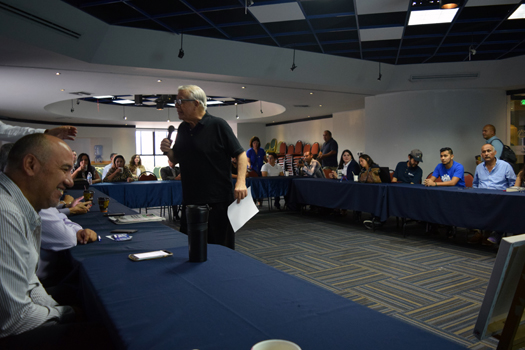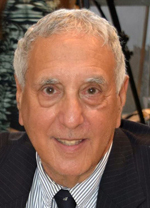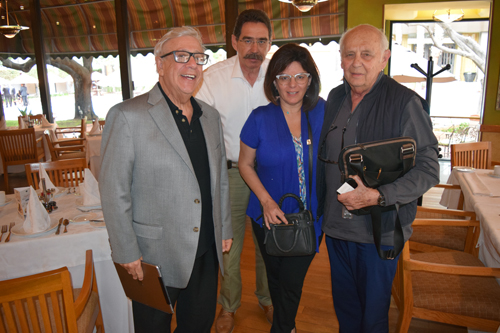
By Donald H. Harrison

TIJUANA, Mexico –Tijuana philanthropist Jose “Pepe” Galicot says when he was a child, his Sephardic Jewish family was so poor that when they moved from Mexico City to Tijuana, they couldn’t afford to buy food. So, they packed enough from home for what they thought would last for five days, but by the fifth day, in that August sun of 1946, all the food had spoiled. Galicot’s father found a job, and after making $100, went to a casino, hoping to double his money or even better. Instead, he lost it all, and never gambled again. There was a hard lesson in this not only for the senior Galicot, but the rest of his family. Success demands hard work.
Galicot today chairs and largely underwrites Tijuana Innovadora—an ambitious program to boost Tijuana’s image and to help its poorer citizens. Galicot’s was a classic rags-to-riches story on the Mexican side of the U.S. border, said Jack Winer, a friend and fellow Jewish community member. Today a man of means, Galicot is engaged in a mission of tikun olam—tying to make the world generally and Tijuana specifically a better place.
As a child, Galicot peddled “shmatas” – textiles – and later in life started a beauty supply business, which grew from a single store to a large wholesale supplier. However, the bottom fell out of his business when Mexico devalued the peso.
In response, the manager of one of Galicot’s concerns in La Paz decided to convert the property into a discotheque, painting it all black and putting in primitive lights. Winer, a sculptor and architect who previously had designed 54 discotheques, suggested to Galicot that he open a discotheque of his own in Tijuana. They decided to visit the best-known discotheques in the world, traveling to New York and to several countries in Europe They distilled what they thought were the best features of each, and opened a disco in Tijuana which was called, simply, “Oh!”
Winer said the discotheque was an immediate hit, attracting lines 500 persons long for a good ten years. Celebrities like Madonna and Robin Williams were known to frequent the club and sometimes even the famous—or the future famous—simply could not get in.
Eventually, Galicot sold the discotheque to people who gave him a down payment and then failed to keep up the payments. Neither did they pay back a loan to the bank, resulting in the bank seizing the property. Banks do not know how to run discotheques, and before too long it was “Oh, no!” instead of “Oh.” It went out of business.
Galicot meanwhile had moved on to other businesses—in particular real estate. He bought and built properties in Mexico City, Cancun, Playa del Carmen, Cabo San Lucas, and Tijuana, and he continues to do so. Meanwhile his wife Chana’s and his two sons, Rafael and Gregorio, increased the family’s fortunes by becoming operators of an international pre-paid telephone card business, BBG Communications Inc. Today the father and the sons share offices in Tijuana.
***
Tijuana Innovadora was founded a decade ago by Galicot; Winer; marketing expert Tomas Perrin; Alejandro Bustamonte, a vice president of Plantronics; and other business people to promote the positive aspects of Tijuana, which was reeling, both physically and in its image, from drug war-inspired violence.
According to Winer, “In 2008-2009, there was a lot of violence, and there was a lack of identity. People who lived here in Tijuana for many, many years, if you asked them ‘Where are you from?’ would respond ‘I am from Sonora,’ or ‘I am from Mexico City’ or ‘I am from Guaymas’ – anywhere except Tijuana. They were ashamed to say, ‘I am from Tijuana’ because there was no sense of belonging, or identity, no pride, at all.”
At that time, said Winer, Tijuana exported some “$85 million a day” in goods to the United States—largely thanks to large assembly plants along the U.S. border known as maquiladoras. “But nobody knew about the maquiladora program and the various local industries. Even the Tijuanans didn’t know what was happening, so we decided to make them proud of what they are doing. So, we organized the first Tijuana Innovadora, held in 2010.”
At an estimated cost of $5 million, this was a 15-day festival that attracted over 700,000 people. It included booths at which Tijuana companies, including maquiladoras that manufacture such diverse items as blue tooth devices, solar panels, TV sets, and heart valves, exhibited their wares. The festival also featured musical programs, dance, lectures, and appearances by a wide variety of celebrities including Mexican President Felipe Calderon, former U.S. Vice President Al Gore, television personality Larry King, Mexican billionaire Carlos Slim; Twitter co-founder Biz Stone, Wikipedia cofounder Jimmy Wales, and a handful of Nobel Prize winners in various fields.
Whereas some of these celebrities were initially reluctant to come to Tijuana, given its reputation for violence, they and other attendees came away from “Innovative Tijuana” (as Tijuana Innovadora translates into English) quite impressed not only with Tijuanans’ accomplishments but also with their potential.
It was decided to hold a similar event every second year. In 2012, the program emphasized the many economic connections between San Diego and Tijuana to illustrate the thesis that they are not two separate cities, standing back to back, but rather they are partners in a regional embrace. Winer said a poll prior to the 2012 event indicated only 9 percent of San Diegans believed that Tijuana was important to them. Now, he said, upwards of 60 percent of San Diegans understand Tijuana’s economic importance.
The third Tijuana Innovadora in 2014, which Winer says was less successful, attempted to catalyze the “Mexican Diaspora” into developing the same kind of appreciative and loving relationship for Mexico as the Jewish Diaspora has for Israel.
The most recent celebration, in 2016, focused on creativity in the arts and in business, particularly in the area of entrepreneurship.
Galicot said he anticipates that in 2018, the Tijuana Innovadora festival will focus on Mexican democracy. He hopes to bring major candidates for the presidency of Mexico to participate in a forum; and expects to have other celebrities from various fields discuss Mexico’s progress.
Over the years, a number of Israelis have participated in Tijuana Innovadora events including Tel Aviv Mayor Ron Huldai, Israeli-American architect Neri Oxman, and representatives of the worldwide Maccabiah movement.
Tijuana Innovadora expanded from staging biannual celebrations to also fostering ongoing programs in a variety of fields.
Every Wednesday, at promptly 8 a.m., Galicot convenes a meeting of the representatives of at least 10 groups that operate under the Tijuana Innovadora umbrella. The representatives give short, concise reports of their activities, keeping in mind that the meeting is supposed to conclude by 9 a.m. Several representatives of Mexican media routinely cover the meetings, not only to hear what Tijuana Innovadora is doing, but also to hear guest reports from other non-profit agencies which seek greater exposure by publicly briefing the Tijuana Innovadora participants. On the day I attended, a guest organization battling women’s cancer gave a brief summary of her organization’s activities.
The ten ongoing programs of Tijuana Innovadora are Casa de las Ideas (a program for the children of jail inmates to expose them to positive possibilities for their lives, including operating food trucks); Arte en la Industria (a program to bring art works to the factories and other work places); Sinfonia Juvenil or the youth symphony; InnovaModa (a program to promote the creation of high fashion clothing lines in Tijuana); Voluntarios a Lideres (to promote leadership through volunteer exposure); Sports; Communa Creativa (bringing together business, science, and the arts); Tijuana Verde (green Tijuana, an ecology-focused program; TI Talks (lectures by prominent people) and Paseo de la Fama (Walk of the Famous) to recognize people of accomplishment on both sides of the border. While these programs require subsidies from the umbrella organization, each is supposed to work toward self-sufficiency.

Over brunch, Galicot and I were joined by Winer; Eduardo Gurria, director of Tijuana Innovadora’s Arte en la industria (art in industry) program, and Claudio Basurto, director of its Comuna Creativa (Creative Community) program.
I learned that Winer decided to settle in the Tijuana/ San Diego region after working with Galicot on the “Oh!” discotheque. His father, Abraham Winer, had been active in Poland in an Organization for Jewish Health, which he helped re-create in Mexico City in 1940. Jack Winer grew up speaking both Yiddish and Spanish, served on the board of the Yiddishe Shul in Mexico City, and for a while was involved in Mexico’s Yiddish Theatre. As a Mexico City architect, he designed some synagogues including Shaare Shalom, and the interior of Ramat Shalom. Since coming to Tijuana, he has sculpted numerous pieces, including a “scream” of a Holocaust Survivor, which Galicot presented to Israel’s then President Shimon Peres; as well as works that may be found at Tijuana’s Cultural Center and on the grounds of the Chabad Hebrew Academy in the Scripps Ranch neighborhood of San Diego.
Gurria told me about the art in industry program which had its genesis when one of Mexico’s most famed muralists, Raul Anguiano, made available to him and Galicot 58 pieces of art, not to be sold, but to be put on public display. Initially, they opened a gallery in downtown Tijuana which offered free admission, and “if we had 200 people a week come into the gallery, we thought it was successful.” But eventually the city, which had made the premises available, reclaimed the space. Gurria then approached the industries which exhibit at the big Tijuana Innovadora bi-annual events and suggested that they display some of the works in their factories. “Some said ‘yes,’ some said ‘no’ but the fact of the matter is that we now have some 800 art pieces on display” at nearly 30 venues. The industries pay a fee for the art pieces, whereas educational institutions where they also are displayed, receive them gratis. Instead of a couple hundred viewers a week, the art is enjoyed by many thousands weekly.
Gurria, a civil engineer by background, said the program has had some surprising results. At CareFusion, a company that specializes in patient safety and medication control, paintings were on display for two months. When Arte en la Industria came to retrieve them, and place them elsewhere, “about 30 ladies protested, ‘Someone is taking our paintings!’ The workers were so unhappy that management feared labor unrest could result. Management told Gurria, “Get us another collection before 4 p.m., or we will hang you there (on the empty wall).” Gurria complied, bringing in the works of other artists, and now the program has been in existence at CareFusion for five years. “The workers are very grateful to the owners of the company, and the company is happy with us,” Gurria said.
In fact, Gurria added, CareFusion now opens its plant on Saturdays to the families of its workers so they too can enjoy the paintings. One little girl, perhaps of kindergarten age, was quite impressed with the exhibit. The next day, when children were asked to describe what their parents do, the child said her mother works in a maquiladora. Other children teased her because the wages at maquiladoras are said to be lower than in local industries. “I don’t know about that,” answered the little girl, “but where my mom works, they even have a museum!” In fact, said Gurria, the paintings are displayed along a long corridor, about 300 feet long, and look very much like they are in a museum.
Besides CareFusion, there are four other venues, in factories and public places, which have been motivated to create special exhibit space as a result of the program. Two of them are named for Anguiano, who was in Mexico’s second generation of muralists after Diego Rivera, José Clemente Orozco, and David Alfaro Siqueiros.
Basurto, the director of Comuna Creativa, said she helps to promote such blooming businesses in Tijuana as video games, the film industry, bloggers, You Tubers, and news media. “Nowadays,” she said, “you have to speak three languages: Spanish, English, and code.”
She had started her career as an elementary school teacher, but branched into communication sciences after realizing that most textbooks only provided information, without feeding children’s hunger to learn. She began creating materials to help children become self-learners, and therapeutic art programs to help adults work out their problems. She also worked at the Tijuana Cultural Center. When Galicot and Winer began placing public murals in Tijuana, approximately a decade ago, just before the start-up of Tijuana Innovadora, Basurto became part of their team. “I have been around art and sculpture ever since as part of my job. The people who are making their living from art, most of them can’t pay the rent, so what I try to do is to get them together with the science and business people,” she said.
Galicot said participating in various Jewish organizations during much of his life prepared him both for a business career and for presiding over the diverse, growing Tijuana Innovadora program.
“We are in a very interesting moment,” he said. “Every sphere grows and has a good relationship with society. We are friends with everybody. We have a fantastic relationship with San Diego in many fields, and we are recognized because we are at nearly every event that they do. They have more and more understanding of our purposes.”
Tijuana Innovadora has been learning as it goes, “and like the Mexican proverb, ‘We make a road as we walk,’” he added. “This is a very democratic organization and we work very hard together. We are happy we are doing something for the city. We have been giving lectures at Stanford University, in Spain, and in Israel. People are coming here from other cities to see this concept.”
While others often praise Galicot as the founder of Tijuana Innovodora, he showers accolades on his daughter Jaye, whom he describes as the idea person and co-founder for the first two festivals. The same time she was organizing the festival, he said “she was fighting cancer and from bed putting the whole show together. She was responsible for all the funding and personalities; they were all the doing of her and her friends, not ours. Former President Calderon adored her and believed in her and supported her for the first two festivals.
“She is just a tornado of love and effort and didn’t make one penny from the millions of dollars raised to do this. Before the first Tijuana Innovadora, she was diagnosed with cervical cancer and she would make the press conferences and pursue the dollars and the speakers, even with her wig. My daughter is brilliant, a fighter, a visionary who wanted to give me kavod. She got people from Israel and as many Jewish rock stars from abroad as she could. She did more than anyone can do. She is something special!”
*
Harrison is editor of San Diego Jewish World. He may be contacted via donald.harrison@sdjewishworld.com